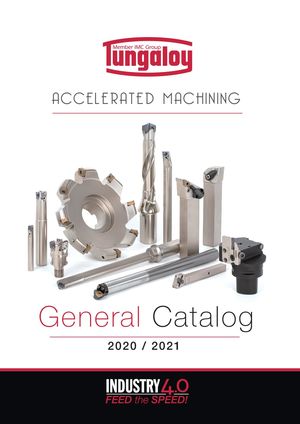Каталог Tungaloy зубофрезерование - страница 58
Навигация

General Description Development of gear skiving has been started at the beginning of the Gear skiving is a continuous cutting process for the production of so-called twentieth century. The new machining process for production of gears was rotationally symmetrical periodic structures, primarily gears. The skiving then applied for a patent by Wilhelm von Pittler in 1910. Although gear tool and the work gear rotate with crossed axes according to a helical gear skiving promised great potential in terms of productivity and flexibility, it pair. With the helical gear pairing, the movement is divided into a rolling was not successful in practice and was forgotten. The technical possibilities and a screwing part, which becomes a sliding cutting movement when of that time were not yet available in the areas of machine control and skiving. The larger you choose the cross-axis angle, the more the rolling tool performance for this high-performance machining process. Thanks to component decreases and the screwing component increases, which leads to enormous progress in both machine tools and tools, thanks to modern cut- an increase of cutting speed. Cutting speed can only be varied by changing ting materials and coatings, gear skiving is now suitable for serial production axis arrangement and speed of tool and work gear. Skiving tool and work and promises to be an interesting alternative to the established machining gear receive rotary movements that are related to each other in the ratio of processes such as hobbing and gear shaping the number of teeth z2/z0. The cross-axis angle ∑ is equal to the difference in the case of opposing flank directions; in the case of flank directions in the same direction, it is equal to the sum of the helical angles of skiving tool 0 and work gear 2. 58
 Общий каталог Tungaloy 2020 - 2021
Общий каталог Tungaloy 2020 - 2021 Каталог Tungaloy инструмент для автоматов швейцарского типа
Каталог Tungaloy инструмент для автоматов швейцарского типа Каталог Tungaloy глубокое сверление 2
Каталог Tungaloy глубокое сверление 2 Каталог Tungaloy глубокое сверление 1
Каталог Tungaloy глубокое сверление 1 Брошюра Tungaloy новая продукция
Брошюра Tungaloy новая продукция